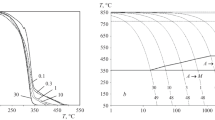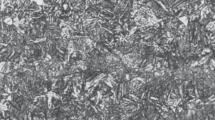Conclusions
Quenching and tempering of cast ferritic — pearlitic steels refines the grains and makes it possible to increase the yield strength and the stress at which crack formation begins with almost no change in hardness, to improve the ductility and toughness at positive and negative temperatures, and to increase the fatigue limit of the steel.
Similar content being viewed by others


Literature cited
E. I. Pinchuk, I. P. Volchok, and Yu. A. Shul'te, "Attachment to metallographic microscope for observing plastic deformation and failure of metals," Zavod. Lab.,36, No. 5, 628–629 (1970).
I. P. Volchok, Yu. A. Shul'te, and E. I. Pinchuk, "Role of nonmetallic inclusions in failure of cast steel," Lit. Proiz., No. 9, 27 (1972).
Additional information
V. Ya. Chubar' Zaporozh'e Machine Construction Institute. Translated from Metallovedenie i Termicheskaya Obrabotka Metallov, No. 5, pp. 74–75, May, 1975.
Rights and permissions
About this article
Cite this article
Volchok, I.P., Minakova, V.I. Effect of structure on deformation and failure of cast steel. Met Sci Heat Treat 17, 444–446 (1975). https://doi.org/10.1007/BF00663232
Issue Date:
DOI: https://doi.org/10.1007/BF00663232


